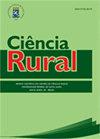农用工业残留物在小反刍动物胃肠道线虫防治及牧草施肥中的应用
IF 0.9
4区 农林科学
Q3 AGRONOMY
引用次数: 0
摘要
摘要:小反刍动物的寄生虫病使农村活动变得不切实际,这仍然是通过使用驱虫药来控制的。本研究评价了4种农工残余物作为肥料在控制小反刍动物自由生活期GIN中的作用。蟹壳、麻瓜、生物炭和有机残留物在花盆(5.0 kg土壤)中使用,与马塞草(Megathyrsus maximum cv)一起栽培。马赛)。此外,这些罐子被携带GIN自然多特异性感染的绵羊粪便污染。接下来,将残留物单独施用于土壤中,液体50ml /罐,固体50g /罐。manipueira治疗的L3数量最少。与有机肥处理(823.89)和生物炭处理(689.34)相比,牧草中MS-1的回收率为202.44 kg。但与对照组比较,四组间差异无统计学意义(P < 0.05)。这些农工残留物可以用作有机肥料;然而,这些都无助于控制绵羊的GIN。本文章由计算机程序翻译,如有差异,请以英文原文为准。
Agro-industrial residues in the control of gastrointestinal nematodes of small ruminants and fertilization of forages
ABSTRACT: Verminosis in small ruminants can render rural activity impractical, which is still controlled through the administration of anthelmintics. The present study evaluated four agro-industrial residues as fertilizer in the control of GIN of small ruminants in the free-living stage. Crab shell, manipueira, biochar, and organomineral residues were used in pots (5.0 kg of soil) and cultivated with Massai grass (Megathyrsus maximum cv. Massai). Further, the pots were contaminated with feces from sheep carrying a natural multispecific infection by GIN. Next, the residues were applied individually to the soil, with 50 mL/pot for liquid and 50 g/pot for solid residues. Treatment with manipueira showed the lowest number of L3.kg MS-1 recovered from the grass (202.44), when compared with treatments using organomineral (823.89) and biochar (689.34). However, there was no statistically significant difference (P < 0.05) between the four treatments as compared to the control group. These agro-industrial residues can be used as organic fertilizers; however, these will not help in the control of GIN in sheep.
求助全文
通过发布文献求助,成功后即可免费获取论文全文。
去求助
来源期刊

Ciencia Rural
AGRONOMY-
CiteScore
1.70
自引率
0.00%
发文量
233
审稿时长
2-4 weeks
期刊介绍:
The purpose of Ciência Rural is to publish the results of original research, note and reviews which contribute significantly to knowledge in Agricultural Sciences. Preference will be given to original articles that develop news concepts or experimental approaches and are not merely repositories of scientific data. The decison of acceptance for publication lies with the Editors and is based on the recommendations of Editorial Comission, Area Committee and/ or ad hoc reviewers. The editors and reviewers are external to the institution.
 求助内容:
求助内容: 应助结果提醒方式:
应助结果提醒方式:


